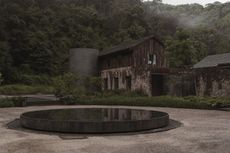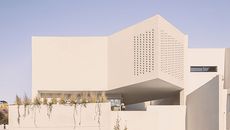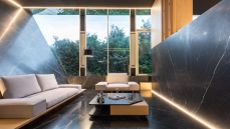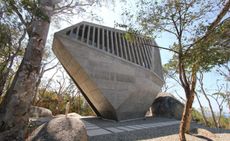Alberto Kalach and Grupo Habita’s Hotel Terrestre scoops Wallpaper* Design Award 2022
Featuring sustainable architecture, 360-degree vistas of sea, jungle and mountains, and a considered take on luxury, Puerto Escondido’s brand new Hotel Terrestre is Wallpaper’s Best Hotel for 2022
- (opens in new tab)
- (opens in new tab)
- (opens in new tab)
- Sign up to our newsletter Newsletter
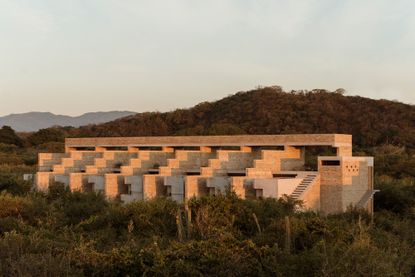
Hotel Terrestre peeks out of the rich foliage of Mexico’s Puerto Escondido, earthy, strong, almost elemental, and at the same time otherworldly. The building, although newly opened, appears to belong to the land, like it’s always been there. It’s just as its architect, Mexico City-based Alberto Kalach, intended: ‘The constructions are tucked into the landscape, as if they were there for hundreds of years. A certain ancient but also futuristic feeling characterises the architecture. One hundred per cent solar-powered, and low-energy consumption, it plays with the sun and the wind.’
Commissioned for Mexican boutique hospitality developer Grupo Habita, the hotel is tucked into the landscape of this idyllic west coast resort region, sharing a beach with neighbours such as artist Bosco Sodi’s Casa Wabi by Tadao Ando, and Federico Rivera Rio’s Hotel Escondido. All overlook the Pacific Ocean and Oaxaca’s mesmerising green-blue mountains, uniting 360-degree vistas of sea, jungle and sierra.

A dive pool in one of the 14 suites of Hotel Terrestre, each overlooking the garden, with the Pacific Ocean in the foreground
Indeed, when Grupo Habita’s co-founder, Carlos Couturier, first imagined his new outpost in this rich part of Mexico, it was this balance of the natural and the somewhat mystical that he had in mind – his thought process also explains the hotel's name. ‘Terrestre is not a hotel. It is a journey. Conceived based on the principle of how “aliens” would imagine life of humans (terrestres) on the planet,’ he says. ‘We, as humans, are obsessed with life in other galaxies, in faraway satellites or planets. But, how weird are we (terrestres) through the eyes of aliens? The Earth and nature are our most valued assets as human beings. ‘Terrestre is a share of this paradise called Earth. Our goal is to preserve and enhance our land. To rethink wellness.’
Existing venues by the same group include Mexico City’s Habita, designed by Enrique Norten and Bernardo Gómez-Pimienta, Habita MTY in Monterrey (Best new hotel in the Wallpaper* Design Awards 2010) with interiors by Joseph Dirand Architecture, and The Robey in Chicago, designed by Belgian collaborators Nicolas Schuybroek Architects and Marc Merckx Interiors. Kalach’s other project for Grupo Habita, also in the area, the restaurant Kakurega Omakase, scooped the Best Hideaway gong at the Wallpaper* Design Awards 2021. All the locations demonstrate the same ambition and sensitivity, while placing the visitor experience and a considered take on luxury at the heart of each scheme.

A suite at Hotel Terrestre, featuring a pair of 'Ruiseñor' (Mockingbird) chairs in tzalam wood and cotton, designed by Oscar Hagerman and manufactured by Canto Artesanos
Kalach is dedicated to crafting buildings that are in tune with nature and follow principles of sustainable architecture. His past works, such as the arch-defined Casona Sforza in the same region, and a private home in Valle de Bravo (W* May 2020), showcase this well, employing natural materials and minimising energy consumption. He designed Terrestre in the same spirit, using a range of eco strategies. There’s passive cooling, solar panels and locally sourced materials, and the whole is engulfed in native planting, such as copales, burseras (palo mulato), mesquites, thevetia, tabebuias, lantanas, and a variety of bromeliads and orchids. An ecosystem of birds and butterflies makes its home there, fluttering between the structure’s textured, sandy brick walls and tropical macuil hardwood shutters.
RELATED STORY

Kakurega Omakase wins Best Hideaway: Wallpaper* Design Awards 2021 (opens in new tab)
Terrestre features 14 rooms, which are situated in low, independent bungalow villas, each of which has a private sand and flower garden, an open-air shower, a generous bedroom and a rooftop with a pool and panoramic views. All are the same, placed in a row, ensuring all guests have an equal, top-quality experience. Two circular bathing pools in the grounds are enclosed within tall walls and not only offer an opportunity for a secluded dip, but also act as a stargazing spot at night and add another important dimension to the complex. ‘Water is the other element that runs through the garden, creating ponds, cascading showers, swimming pools and a mystic spa,’ Kalach explains. The all-day, 40-seat, open-air restaurant within the complex, also named Terrestre, is run by chefs Pamela Maudy and Geoffrey Antonino, who reinterpret the tradition of Mexican herbalism and provide a contemporary twist to local delicacies. Specialities include milpa soup (made with chepil, with corn and pumpkin flower), and plantain molotes with cheese from Istmo. A wellness centre, a library, a towering brick outdoor shower folly, and a beach bar called Lunático complete the offerings on site.

Alberto Kalach's design for the folly at Hotel Terrestre, which bears a resemblance to his chimney tower for the nearby Casa Wabi art foundation
The interiors, done in collaboration with design studio RB + K, are just as carefully considered as the architecture. They feature custom works by Mexican architect and designer Oscar Hagerman – a collaboration that marks a first for Grupo Habita. The pieces, which span from tweaks on Hagerman’s iconic ‘Ruiseñor’ chairs to several entirely new, bespoke elements, were selected for their timeless quality and references to rural Mexican furniture design. They were also all built locally, in Mexico (this attitude around locality extends to bath amenities and cooking ingredients too). ‘Terrestre is a mix of novelty and purity,’ concludes Couturier. ‘[It is] made for humans, to enjoy the luxuries of Earth.’ And this spot in the Mexican jungle, nestled next to nature, art and respectful architecture, really feels like the ideal place to do so.

The shadow of a native nopal cactus falls on the brise soleils at Hotel Terrestre

The stairs and first suite at Hotel Terrestre

A terrace suite, featuring a king-size outdoor bed, a private pool, with unobstructed views of the jungle and the Pacific Ocean in the distance

Detail of a brick stairway at Hotel Terrestre

INFORMATION
This article will feature in the April 2022 issue of Wallpaper* (W*276), on newsstands from 10 March
kalach.com (opens in new tab)
terrestrehotel.com (opens in new tab)
Ellie Stathaki is the Architecture Editor at Wallpaper*. She trained as an architect at the Aristotle University of Thessaloniki in Greece and studied architectural history at the Bartlett in London. Now an established journalist, she has been a member of the Wallpaper* team since 2006, visiting buildings across the globe and interviewing leading architects such as Tadao Ando and Rem Koolhaas. Ellie has also taken part in judging panels, moderated events, curated shows and contributed in books, such as The Contemporary House (Thames & Hudson, 2018) and Glenn Sestig Architecture Diary (2020).
-
 Men’s engagement rings for modern grooms
Men’s engagement rings for modern groomsMen’s engagement rings, whether classic or colourful, make for sentimental tokens
By Hannah Silver • Published
-
 Longchamp unites with D’heygere on a playful collection made to ‘transform the everyday’
Longchamp unites with D’heygere on a playful collection made to ‘transform the everyday’Inspired by Longchamp’s foldaway ‘Le Pliage’ bag, this collaboration with Paris-based jewellery and accessories designer Stéphanie D’heygere sees pieces that ‘transform and adapt’ to their wearer
By Jack Moss • Published
-
 Last chance to see: Marc Newson’s all-blue designs in Athens
Last chance to see: Marc Newson’s all-blue designs in AthensGagosian gallery Athens presents new blue furniture and objects by Marc Newson
By Rosa Bertoli • Published
-
 Mexican bolthole Los Durmientes offers total immersion in nature
Mexican bolthole Los Durmientes offers total immersion in natureLos Durmientes by Bernardo Chavez Peón – a picturesque Mexican bolthole makes a dreamily idyllic retreat
By Ana Karina Zatarain • Published
-
 Best Private House, the shortlist: Wallpaper* Design Awards 2023
Best Private House, the shortlist: Wallpaper* Design Awards 2023We reveal the five shortlisted homes competing for Best Private House: Wallpaper* Design Awards 2023
By Ellie Stathaki • Published
-
 Best Public Building, the shortlist: Wallpaper* Design Awards 2023
Best Public Building, the shortlist: Wallpaper* Design Awards 2023We reveal the shortlist for Best Public Building: Wallpaper* Design Awards 2023
By Ellie Stathaki • Published
-
 Casa Sexta by All Arquitectura is an exemplar of urban minimalism
Casa Sexta by All Arquitectura is an exemplar of urban minimalismCasa Sexta by All Arquitectura brings together domestic warmth and minimalist architecture in the outskirts of Mexico City
By Ellie Stathaki • Published
-
 Mexico City apartment transformed through sliding walls and folding screens
Mexico City apartment transformed through sliding walls and folding screensMultifaceted urban Mexico City apartment is a transformable wonderland by Archetonic Architects
By Jonathan Bell • Published
-
 Mexico City home draws on its city's rich midcentury modern legacy
Mexico City home draws on its city's rich midcentury modern legacyVentana House in Mexico City is the home and workspace of architect José Juan Rivera Rio of JJRR/Arquitectura
By Ellie Stathaki • Last updated
-
 Architecture news: Letter from Mexico
Architecture news: Letter from MexicoBy Cathelijne Nuijsink • Last updated
-
 Venice Architecture Biennale 2023 curator Lesley Lokko on decolonisation, decarbonisation and diversity
Venice Architecture Biennale 2023 curator Lesley Lokko on decolonisation, decarbonisation and diversityThe Ghanaian-Scottish architect, who will curate the 2023 Venice Architecture Biennale, sets out to tackle global issues through her new school in Accra
By Ellie Stathaki • Last updated



